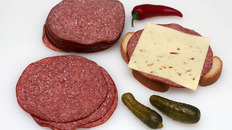Meats and Sausages
Lebanon Bologna (with starter culture)
| Meats | Metric | US |
|---|---|---|
| beef | 1000 g | 2.20 lb. |
Ingredients per 1000g (1 kg) of meat
| salt | 28 g | 5 tsp. |
| Cure #1 | 2.5 g | ½ tsp. |
| sugar, 3% | 30 g | 2 Tbsp. |
| dextrose (glucose), 0.3% | 3.0 g | ½ tsp. |
| pepper | 3.0 g | 1½ tsp. |
| allspice | 2.0 g | 1 tsp. |
| cinnamon | 2.0 g | 1 tsp. |
| cloves, ground | 1.0 g | ½ tsp. |
| ginger | 0.5 g | ⅓ tsp. |
| T-SPX culture | 0.12 g | use scale |
Instructions
- Grind beef through 1/8 - 3/16” (3-5 mm) plate.
- Mix ground beef with all ingredients, including starter culture.
- Stuff sausage mix into 40-120 mm casings. Natural beef middles, collagen or fibrous casings. The larger casings are tied and stockinetted or laced with butcher twine for support as this is a large and heavy sausage.
- Ferment at 24º C (75º F) for 72 hours, 90-85% humidity.
- Cold smoke for 2 days at < 22º C 72º F, 85% humidity.
- For a drier sausage: dry at 16-12º C (60-54º F), 85-80% humidity.
- Store sausages at 10-15º C (50-59º F), <75% humidity.
Notes
Final pH around 4.6, water activity 0.93-0.96, it is a moist sausage but extremely stable due to its low final pH. The sausage is often left for 3 days at 4-6º C (40-43º F) for additional ripening.
If no cold smoke is available, smoke with hot smoke for 6 hours. Start at 110º F (43º C), then gradually increase temperature and smoke at 120º F (49º C) for 3-4 hours.
Traditionally made Lebanon Bologna is not cooked. To comply with increasingly tougher government regulations for preventing the growth of E. coli 0157:H7, most manufacturers subject this sausage to a heat treatment.


















